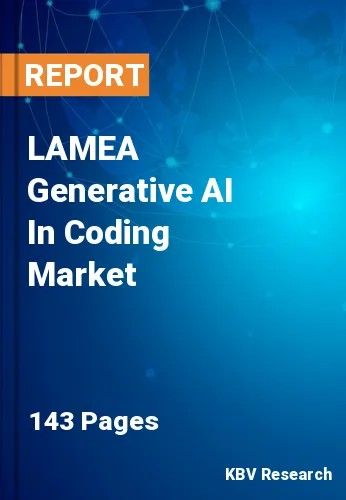Chapter 1. Market Scope & Methodology
1.1 Market Definition
1.2 Objectives
1.3 Market Scope
1.4 Segmentation
1.4.1 LAMEA Generative AI In Coding Market, by Operation
1.4.2 LAMEA Generative AI In Coding Market, by Application
1.4.3 LAMEA Generative AI In Coding Market, by Vertical
1.4.4 LAMEA Generative AI In Coding Market, by Country
1.5 Methodology for the research
Chapter 2. Market at a Glance
2.1 Key Highlights
Chapter 3. Market Overview
3.1 Introduction
3.1.1 Overview
3.1.1.1 Market Composition and Scenario
3.2 Key Factors Impacting the Market
3.2.1 Market Drivers
3.2.2 Market Restraints
Chapter 4. Competition Analysis - Global
4.1 KBV Cardinal Matrix
4.2 Recent Industry Wide Strategic Developments
4.2.1 Partnerships, Collaborations and Agreements
4.2.2 Product Launches and Product Expansions
4.2.3 Acquisition and Mergers
4.3 Market Share Analysis, 2022
4.4 Top Winning Strategies
4.4.1 Key Leading Strategies: Percentage Distribution (2019-2023)
4.4.2 Key Strategic Move: (Partnerships, Collaborations & Agreements: 2023, Mar – 2023, Aug) Leading Players
4.5 Porter’s Five Forces Analysis
Chapter 5. LAMEA Generative AI In Coding Market by Operation
5.1 LAMEA Code Generation Market by Country
5.2 LAMEA Code Enhancement Market by Country
5.3 LAMEA Language Translation Market by Country
5.4 LAMEA Code Reviews Market by Country
Chapter 6. LAMEA Generative AI In Coding Market by Application
6.1 LAMEA Data Science & Analytics Market by Country
6.2 LAMEA Game Development & Design Market by Country
6.3 LAMEA Web & Application Development Market by Country
6.4 LAMEA IoT & Smart Devices Market by Country
Chapter 7. LAMEA Generative AI In Coding Market by Vertical
7.1 LAMEA IT & Telecom Market by Country
7.2 LAMEA Healthcare & Life Sciences Market by Country
7.3 LAMEA Retail & E-commerce Market by Country
7.4 LAMEA BFSI Market by Country
7.5 LAMEA Media & Entertainment Market by Country
7.6 LAMEA Transport & Logistics Market by Country
Chapter 8. LAMEA Generative AI In Coding Market by Country
8.1 Brazil Generative AI In Coding Market
8.1.1 Brazil Generative AI In Coding Market by Operation
8.1.2 Brazil Generative AI In Coding Market by Application
8.1.3 Brazil Generative AI In Coding Market by Vertical
8.2 Argentina Generative AI In Coding Market
8.2.1 Argentina Generative AI In Coding Market by Operation
8.2.2 Argentina Generative AI In Coding Market by Application
8.2.3 Argentina Generative AI In Coding Market by Vertical
8.3 UAE Generative AI In Coding Market
8.3.1 UAE Generative AI In Coding Market by Operation
8.3.2 UAE Generative AI In Coding Market by Application
8.3.3 UAE Generative AI In Coding Market by Vertical
8.4 Saudi Arabia Generative AI In Coding Market
8.4.1 Saudi Arabia Generative AI In Coding Market by Operation
8.4.2 Saudi Arabia Generative AI In Coding Market by Application
8.4.3 Saudi Arabia Generative AI In Coding Market by Vertical
8.5 South Africa Generative AI In Coding Market
8.5.1 South Africa Generative AI In Coding Market by Operation
8.5.2 South Africa Generative AI In Coding Market by Application
8.5.3 South Africa Generative AI In Coding Market by Vertical
8.6 Nigeria Generative AI In Coding Market
8.6.1 Nigeria Generative AI In Coding Market by Operation
8.6.2 Nigeria Generative AI In Coding Market by Application
8.6.3 Nigeria Generative AI In Coding Market by Vertical
8.7 Rest of LAMEA Generative AI In Coding Market
8.7.1 Rest of LAMEA Generative AI In Coding Market by Operation
8.7.2 Rest of LAMEA Generative AI In Coding Market by Application
8.7.3 Rest of LAMEA Generative AI In Coding Market by Vertical
Chapter 9. Company Profiles
9.1 Skillsoft Corporation
9.1.1 Company Overview
9.1.2 Financial Analysis
9.1.3 Segmental and Regional Analysis
9.1.4 Recent strategies and developments:
9.1.4.1 Partnerships, Collaborations, and Agreements:
9.1.4.2 Product Launches and Product Expansions:
9.1.4.3 Acquisition and Mergers:
9.1.5 SWOT Analysis
9.2 CodiumAI
9.2.1 Company Overview
9.2.2 SWOT Analysis
9.3 Snyk Limited
9.3.1 Company Overview
9.3.2 Recent strategies and developments:
9.3.2.1 Acquisition and Mergers:
9.3.3 SWOT Analysis
9.4 Google LLC (Alphabet Inc.)
9.4.1 Company Overview
9.4.2 Financial Analysis
9.4.3 Segmental and Regional Analysis
9.4.4 Research & Development Expense
9.4.5 Recent strategies and developments:
9.4.5.1 Partnerships, Collaborations, and Agreements:
9.4.6 SWOT Analysis
9.5 IBM Corporation
9.5.1 Company Overview
9.5.2 Financial Analysis
9.5.3 Segmental and Regional Analysis
9.5.4 Research & Development Expenses
9.5.5 Recent strategies and developments:
9.5.5.1 Partnerships, Collaborations, and Agreements:
9.5.5.2 Product Launches and Product Expansions:
9.5.6 SWOT Analysis
9.6 Microsoft Corporation
9.6.1 Company Overview
9.6.2 Financial Analysis
9.6.3 Segmental and Regional Analysis
9.6.4 Research & Development Expenses
9.6.5 Recent strategies and developments:
9.6.5.1 Partnerships, Collaborations, and Agreements:
9.6.6 SWOT Analysis
9.7 NVIDIA Corporation
9.7.1 Company Overview
9.7.2 Financial Analysis
9.7.3 Segmental and Regional Analysis
9.7.4 Research & Development Expenses
9.7.5 Recent strategies and developments:
9.7.5.1 Partnerships, Collaborations, and Agreements:
9.7.5.2 Product Launches and Product Expansions:
9.7.6 SWOT Analysis
9.8 OpenAI, L.L.C.
9.8.1 Company Overview
9.8.2 SWOT Analysis
9.9 Tabnine Inc.
9.9.1 Company Overview
9.9.2 SWOT Analysis
9.10. Adobe, Inc.
9.10.1 Company Overview
9.10.2 Financial Analysis
9.10.3 Segmental and Regional Analysis
9.10.4 Research & Development Expense
9.10.5 Recent strategies and developments:
9.10.5.1 Partnerships, Collaborations, and Agreements:
9.10.6 SWOT Analysis

